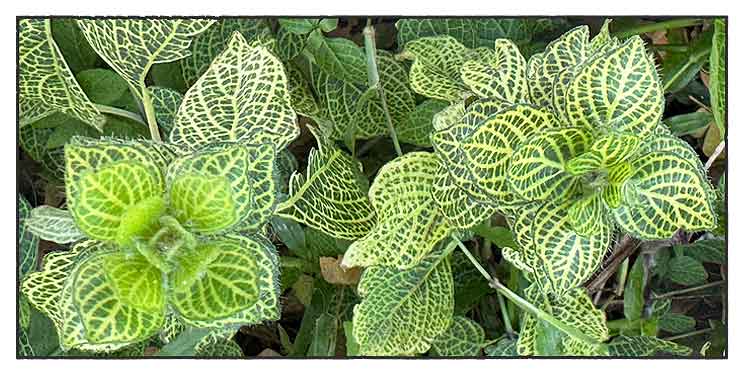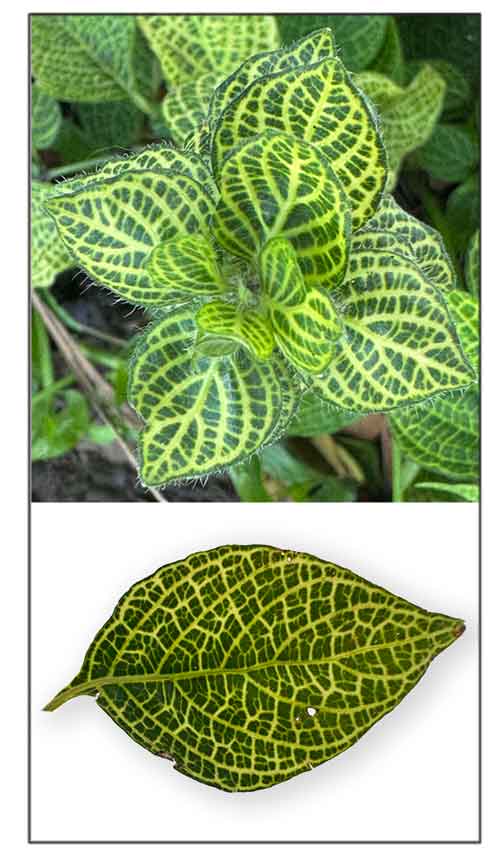
Family • Acanthaceae
Nerve plant
Fittonia albivenis (Lindl. ex Veitch) Brummit
MOSAIC PLANT / FITONIA
xxxx
| Scientific names | Common names |
| Adelaster albivenis Lindl. ex Veitch      | Fittonia |
| Adelaster albovenosus Jacob-Makoy     | Jewel plant (Engl.) |
| Eranthemum rubronervium J.Veitch f. Â Â Â | Mosaic plant (Engl.) |
| Eranthemum rubrovenium J.Veitch f. Â Â Â | Nerve plant (Engl.) |
| Eranthemum verschaffeltii (Lem.) Voss  | Silver fittonia (Engl.) |
| Fittonia albivenis (Lindl. ex Veitch) Brummit  | Silver nerve plant (Engl.) |
| Fittonia argyroneura Coem. Â Â Â | Silver-net plant (Engl.) |
| Fittonia metallica Jacob-Makoy   | Silver threads (Engl.) |
| Fittonia pearcei (H.J.Veitch) Verschaff. Â Â | White nerve plant (Engl.) |
| Fittonia verschaffeltii (Lem.) Van Houtte   | |
| Fittonia verschaffeltii var. argyroneura (Coem.) Regel  | |
| Gymnostachyum argyroneurum (Coem.) J.Verschaff.   | |
| Gymnostachyum pearcei H.J.Veitch  | |
| Gymnostachyum verschaffeltii Lem. | |
| Fittonia albivenis (Lindl. ex Veitch) Brummit is an accepted species. KEW: Plants of the World Online | |
Botany Distribution Constituents Properties Studies Availability |
February 2025
![]()
 |
| Â Â Â Â Â Â Â Â Â Â Â Â Â Â Â Â Â Â Â Â Â Â Â Â Â PHOTOS / ILLUSTRATIONS |
| Photos © Godofredo Stuart / StuartXchange |
Additional
Sources and Suggested Readings |
• |
DOI: It is not uncommon for links on studies/sources to change. Copying and pasting the information on the search window or using the DOI (if available) will often redirect to the new link page. (Citing and Using a (DOI) Digital Object Identifier) |
| Â Â Â Â Â Â Â Â Â Â Â Â Â Â Â Â Â Â Â Â Â Â Â Â Â Â Â Â Â Â List of Understudied Philippine Medicinal Plants |
| Â Â Â Â Â Â Â Â Â Â Â Â Â Â Â Â Â Â Â Â Â New plant names needed The compilation now numbers over 1,500 medicinal plants. While I believe there are hundreds more that can be added to the collection, they are becoming more difficult to find. If you have a plant to suggest for inclusion, native or introduced, please email the info: scientific name (most helpful), local plant name (if known), any known folkloric medicinal use, and, if possible, a photo. Your help will be greatly appreciated. |
• |
 |

 Gen info
Gen info Parts used
Parts used